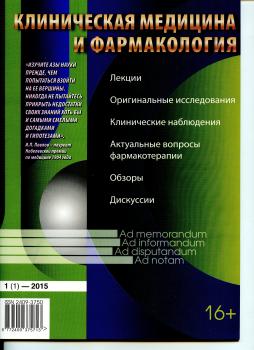Russian Federation
Tula, Tula, Russian Federation
Russian Federation
Russian Federation
Russian Federation
Russian Federation
Russian Federation
The aim of the study is to study in detail the chemical composition of organic matter of common yarrow in order to establish the main biochemical processes responsible for the formation of the composition of the latter. Materials and methods of research. The chemical composition of toluene extract of yarrow was studied by chromatography-mass spectrometry under the following conditions. GC-2010 gas chromatograph connected to a GCMs-TQ-8030 triple quadrupole mass spectrometer running GCMS Solution 4.11 software. The results of studying the chemical composition of toluene extract-a product of sequential exhaustive extraction of yarrow by chromatography-mass spectrometry, which allowed identifying 129 individual compounds for which the quantitative content was determined, mass spectra and structural formulas were obtained, and the structure-group composition of the extract was calculated. Results and discussion. The basis of the extract is determined by hydrocarbons, esters, sterols and carboxylic acids, which account for: 43.59; 15.47; 15.33 and 7.59 (wt.% of the extract), respectively, the content of ketones, alcohols, aldehydes and organosilicon compounds-3.77; 2.77; 1.68 and 6.49 (wt.% of the extract). The presence of phenols and glycosides has not been established; furan and PYRAN fragments are part of the structures of individual alcohols and ketones. Based on the features of the chemical composition, it can be argued that the pharmacological effect of toluene extract of yarrow is determined precisely by the content of hydrocarbons, with the dominance of alkenes, alkynes, arenes and cycloalkanes; sterols of the following types: Betulin, Lupeol, γ-Sitosterol and Sitostenon, Campesterol, 24-Noroleana-3.12-dien; carboxylic acids containing up to three double and triple bonds in the hydrocarbon chain, as well as esters mainly formed by Oxalic and Benzeneacetic acid. Undoubtedly, a certain contribution to the direction of the pharmacological action of this extract is made by organosilicon compounds, the proportion of which is 6.49 (wt.% of the extract).
extract, mass spectrometry, structure-group composition.
1. Aslanova D., Karomatov I.D. Tysyachelistnik obyknovennyy v narodnoy i nauchnoy fitoterapii // Biologiya i integrativnaya medicina. 2018. № 1 (18). S. 167-186.
2. Ahmet'yanov R.T., Hasanova Z.M., Hasanova L.A. Tysyachelistnik obyknovennyy (achillea millefolium L.) v kachestve osnovy dlya produktov funkcional'nogo naznacheniya // Vestnik Bashkirskogo gosu-darstvennogo pedagogicheskogo universiteta im. M. Akmully. 2019. № 1 (49). S. 6-11.
3. Vardanyan L.R., Atabekyan L.V., Ayrapetyan S.A., Vardanyan R.L. Antioksidantnaya aktivnost' eti-lacetatnogo ekstrakta raznyh vidov tysyachelistnika (Achillea L.) // Himiya rastitel'nogo syr'ya. 2018. № 3. S. 61-68.
4. D'yakova N.A.Trava tysyachelistnika kak perspektivnyy istochnik flavonoidov. V sbornike: Mo-lodezh' i medicinskaya nauka. Stat'i VI Vserossiyskoy mezhvuzovskoy nauchno-prakticheskoy konferencii molodyh uchenyh s mezhdunarodnym uchastiem. Redkollegiya: M.N. Kalinikin [i dr.]. 2019. S. 137-140.
5. Kolpakova M.A. Himiko-farmakognosticheskaya harakteristika syr'ya tysyachelistnika obykno-vennogo // Byulleten' medicinskih internet-konferenciy. 2019. T. 9. № 2. S. 66.
6. Komarov B.A. Elementnyy sostav tysyachelistnika obyknovennogo // Razrabotka i registraciya lekarstvennyh sredstv. 2018. № 3 (24). S. 158-161.
7. Lekarstvennye rasteniya v onkologii./V.F. Korsun, K.A.Treskunov, E.V. Korsun, A. Mickonas, red. V.F. Korzun - 2-e izd. ispr. I dopolnennoe Eko-Vektor, 2017. 432 s.
8. Uranova V.V., Mazhitova M.V., Uranov I.O. Izuchenie osobennostey tehnologii vodnyh izvle-cheniy na osnove tysyachelistnika. V knige: Aktual'nye voprosy sovremennogo himicheskogo i biohimiche-skogo materialovedeniya. Materialy V Mezhdunarodnoy molodezhnoy nauchno-prakticheskoy shkoly-konferencii. Bashkirskiy gosudarstvennyy universitet; otv. red. O.S. Kukovinec. 2018. S. 278-281.
9. Fesenko M.S., Smoylovskaya G.P. Izuchenie soderzhaniya flavonoidov v trave tysyachelistnika subobyknovennogo. V sbornike: MOLODEZh', NAUKA, MEDICINA. Materialy 63-y vserossiyskoy mezhvuzovskoy studencheskoy nauchnoy konferencii s mezhdunarodnym uchastiem. Redkollegiya: M.N. Kalin-kin [i dr.]. 2017. S. 679-682.
10. Fes'kov S.A. Tysyachelistnik obyknovennyy achillea millefolium L. V sbornike: Rasteniya Kryma: Prelestnye sosedi. Ser. "Prirodnaya kladovaya Kryma" Simferopol', 2016. S. 82-84.
11. Chusovitina K.A., Karpuhin M.Yu. Farmakologicheskie osobennosti tysyachelistnika obyknoven-nogo (achilléa millefólium L.) // Agrarnoe obrazovanie i nauka. 2019. № 4. S. 31.








